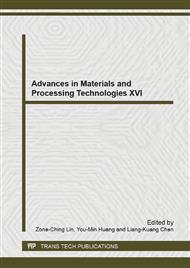p.222
p.230
p.239
p.245
p.253
p.260
p.266
p.274
p.283
Effect of Edge Shape of Tool in Finish Blanking
Abstract:
In the present paper, the finish-blanking method is taken up because it is an easy-to-use method by using a tool with rounded edge and a small clearance between the punch and die. In finish blanking, the process parameters such as the tool shape and clearance are significant. The purpose of the present work is to clarify the effect of tool shape of PW punch in finish blanking. In the present paper, a high-tensile-strength-steel plate with a thickness of 6mm was used. The edge shape of punch was changed, and the clearance was changed within the range of 0.65%t - 12%t. The experimental results show that the edge angle of PW punch should be in the range of 30° - 60°, and the clearance should be less than 2.0%t to obtain the ratio of the burnished surface more than 80%. The edge shape of the punch has a very limited effect on the shear droop, when the clearance is less than 2.0%t. It was also found that the PW punch is more suitable to control the burr depth than Rounded punch.
Info:
Periodical:
Pages:
253-259
Citation:
Online since:
May 2014
Authors:
Keywords:
Price:
Сopyright:
© 2014 Trans Tech Publications Ltd. All Rights Reserved
Share:
Citation:


